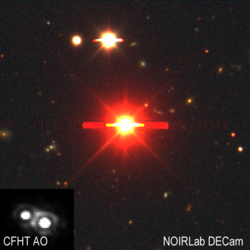Astronomy:GJ 3522
From HandWiki
Short description: Nearby star in the constellation Cancer
| Observation data Equinox J2000.0]] (ICRS) | |
|---|---|
| Constellation | Cancer |
| Right ascension | 08h 58m 56.3208s[1] |
| Declination | +08° 28′ 26.068″[1] |
| Apparent magnitude (V) | 10.98[1] |
| Characteristics | |
| Evolutionary stage | red dwarf |
| Spectral type | M3.5V[2] |
| Astrometry | |
| Parallax (π) | 147.66 ± 1.98[3] mas |
| Distance | 22.1 ± 0.3 ly (6.77 ± 0.09 pc) |
| Details | |
| Other designations | |
DEL 2, IRAS 08562+0840, LHS 6158, LTT 12352, 2MASS J08585633+0828259, WDS J08589+0829AB, USNO-B1.0 0984-00186842 | |
| Database references | |
| SIMBAD | data |
GJ 3522 (G 41–14) is a nearby triple star system, consisting out of a short-period double-line spectroscopic binary[4] and an outer companion that was discovered with adaptive optics on the CFHT.[5] The system is 22 light-years (6.8 parsec) from Earth.[3]
The inner binary orbit each other every 7.6 days. Orbiting around the inner binary the outer companion completes an orbit every 5.7 years.[6] The system has a spectral type of M3.5.[5]
The star shows flares in the optical and x-ray. It also shows activity in H-alpha and ultraviolet.[7]
See also
References
- ↑ 1.0 1.1 1.2 Zacharias, N.; Finch, C. T.; Girard, T. M.; Henden, A.; Bartlett, J. L.; Monet, D. G.; Zacharias, M. I. (2012). "VizieR Online Data Catalog: UCAC4 Catalogue (Zacharias+, 2012)". VizieR On-line Data Catalog: I/322A. Originally Published in: 2012yCat.1322....0Z; 2013AJ....145...44Z 1322. Bibcode: 2012yCat.1322....0Z.
- ↑ Henry, Todd J. (October 1994). "The solar neighborhood, 1: Standard spectral types (K5-M8) for northern dwarfs within eight parsecs". The Astronomical Journal 108 (4): 1437–1444. doi:10.1086/117167. Bibcode: 1994AJ....108.1437H.
- ↑ 3.0 3.1 Henry, Todd J.; Jao, Wei-Chun; Subasavage, John P.; Beaulieu, Thomas D.; Ianna, Philip A.; Costa, Edgardo; Méndez, René A. (2006-12-01). "The Solar Neighborhood. XVII. Parallax Results from the CTIOPI 0.9 m Program: 20 New Members of the RECONS 10 Parsec Sample". The Astronomical Journal 132 (6): 2360–2371. doi:10.1086/508233. ISSN 0004-6256. Bibcode: 2006AJ....132.2360H.
- ↑ Reid, I. Neill; Gizis, John E. (1997-06-01). "Low-Mass Binaries and the Stellar Luminosity Function". The Astronomical Journal 113: 2246. doi:10.1086/118436. ISSN 0004-6256. Bibcode: 1997AJ....113.2246R.
- ↑ 5.0 5.1 Delfosse, X.; Forveille, T.; Beuzit, J. -L.; Udry, S.; Mayor, M.; Perrier, C. (1999-04-01). "New neighbours. I. 13 new companions to nearby M dwarfs". Astronomy and Astrophysics 344: 897–910. ISSN 0004-6361. Bibcode: 1999A&A...344..897D.
- ↑ Hartkopf, William I.; Tokovinin, Andrei; Mason, Brian D. (2012-02-01). "Speckle Interferometry at SOAR in 2010 and 2011: Measures, Orbits, and Rectilinear Fits". The Astronomical Journal 143 (2): 42. doi:10.1088/0004-6256/143/2/42. ISSN 0004-6256. Bibcode: 2012AJ....143...42H.
- ↑ Pritchard, Joshua; Murphy, Tara; Zic, Andrew; Lynch, Christene; Heald, George; Kaplan, David L; Anderson, Craig; Banfield, Julie et al. (2021-02-05). "A circular polarization survey for radio stars with the Australian SKA Pathfinder" (in en). Monthly Notices of the Royal Astronomical Society 502 (4): 5438–5454. doi:10.1093/mnras/stab299. ISSN 0035-8711. Bibcode: 2021MNRAS.502.5438P.
 |


